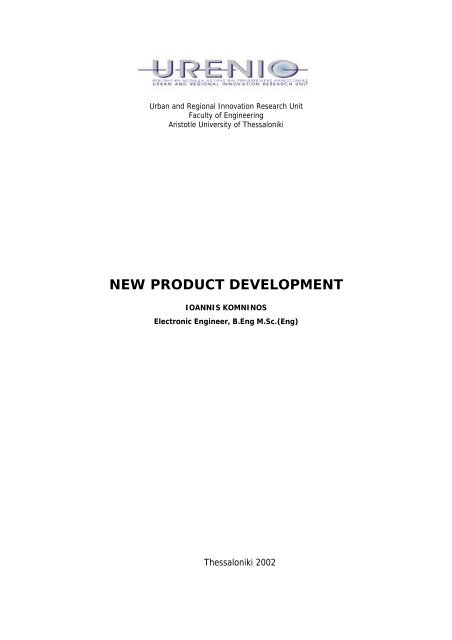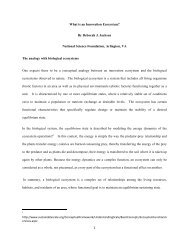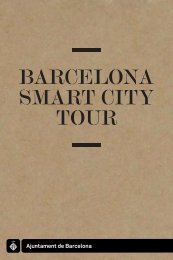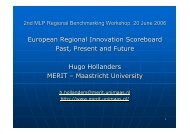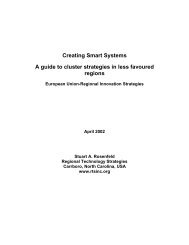NEW PRODUCT DEVELOPMENT - Urenio
NEW PRODUCT DEVELOPMENT - Urenio
NEW PRODUCT DEVELOPMENT - Urenio
Create successful ePaper yourself
Turn your PDF publications into a flip-book with our unique Google optimized e-Paper software.
Urban and Regional Innovation Research Unit<br />
Faculty of Engineering<br />
Aristotle University of Thessaloniki<br />
<strong>NEW</strong> <strong>PRODUCT</strong> <strong>DEVELOPMENT</strong><br />
IOANNIS KOMNINOS<br />
Electronic Engineer, B.Eng M.Sc.(Eng)<br />
Thessaloniki 2002
New Product Development 2<br />
INTRODUCTION<br />
The development of a new product (hereonto New product development – NPD) by a<br />
company begins when the need to create a new product appears either due to the<br />
emergence of a new technology, or the appearance of a competitive product or a<br />
change in the existing legal framework and is completed with the final introduction of<br />
the product in the market.<br />
A company or an enterprise may proceed to a new product development whether that<br />
company or enterprise is part of a rapidly changing market or not. (A rapidly changing<br />
market is one where a rapid change in technology leads to swift changes in the<br />
structure of the market, the consumer habits and their attitude).<br />
Those new products may be based on other already existing ones (see Example 1) and<br />
act as a complement or improvement to existing offerings, or may be totally new<br />
products based on new technology without the need of support from others (Stand<br />
alone products).<br />
Research and Development<br />
Customer needs<br />
Product strategy<br />
Brainstorming<br />
Selection<br />
of idea<br />
Design and<br />
redesign<br />
Production<br />
preparation<br />
Product<br />
optimisation or<br />
withdrawal<br />
Objectives<br />
Product ripenning<br />
Results<br />
A company or enterprise decision to develop a new product is probably one of the<br />
most important decisions to be made in the history of that company or enterprise,<br />
because a new product development is directly linked with the development and the<br />
evolution of that very company or enterprise. The following question, which should<br />
be raised each time, is deemed necessary for the development of a new product, and it<br />
is very characteristic and indicates the relationship between a new product<br />
development and the future evolution of the company or enterprise: “Where does the<br />
company stand today and where should it be a decade later”.<br />
For a company to develop a new product, the development and good management of a<br />
Research and Development (R&D) department within the company is essential. The<br />
administration, management and improvement of such departments constitute a fairly<br />
URENIO - Urban and Regional Innovation Research Unit<br />
http://www.urenio.org
New Product Development 3<br />
difficult task, given the fact that market conditions and demands constantly change<br />
and future developments may be unpredictable.<br />
For the proper development of a new product, an enterprise should follow the New<br />
Product Development Model. It is important for that enterprise to use a questionnaire<br />
- check list in order to obtain an initial estimate for the need to develop a new product,<br />
the way to develop it and the extent to which this development is feasible.<br />
URENIO - Urban and Regional Innovation Research Unit<br />
http://www.urenio.org
New Product Development 4<br />
<strong>PRODUCT</strong> <strong>DEVELOPMENT</strong> MODEL<br />
1. Creation of ideas<br />
2. Evaluation of ideas – Selection of final idea<br />
3. Product development<br />
4. Manufacture of prototype<br />
5. Product promotion<br />
1. CREATION OF IDEAS<br />
Prior to the development of a new product, it is necessary to have some initial ideas<br />
for new products, one of which will become the new product. The creation of those<br />
ideas forms the basis for the proper development of a new product.<br />
α. IDEAS FROM CUSTOMERS OR USERS OF COMPANY <strong>PRODUCT</strong>S<br />
Ideas for new products can quite easily ensue from the very customers of the company<br />
or from users of previous company products. In this case, the golden rule is for the<br />
company to offer its customers what they want and not what the company thinks they<br />
want. Gathering such ideas is very easy with the use of questionnaires either upon the<br />
purchase of a product (research at the product outlets), or over the phone (telephone<br />
research based on the company clientele list), or through the Internet (on-line<br />
questionnaires).<br />
β. IDEAS DERIVING FROM MARKET RESEARCH<br />
Market research is another good source of ideas for new products. The successful<br />
development of a new product requires very good knowledge of customers and their<br />
needs and, more generally, of the market to which the new product is addressed. Thus,<br />
all the more companies or enterprises develop new products based on the orientation<br />
of the market (Market-orientation NPD firms). The orientation of the market can be<br />
defined as a set of interlinked procedures and activities, aiming at the creation and<br />
fulfilment of customer needs through constant assessment of those needs (need<br />
assessment). In other words, the enterprises that develop their products based on<br />
market orientation, develop tools to study the market and elaborate development<br />
strategies to constantly satisfy the needs and desires of the customers – consumers.<br />
URENIO - Urban and Regional Innovation Research Unit<br />
http://www.urenio.org
New Product Development 5<br />
Market-orientation studies on companies in Scandinavian countries and the USA have<br />
shown that, despite a significant and intense government intervention and a low level<br />
of competition, those enterprises barely use this mean. On the contrary, Japanese<br />
enterprises depend all the more on the development of products through marketorientation<br />
studies. As to European and other Asian enterprises, studies have shown<br />
that the market-orientation analysis process is very important especially for those<br />
enterprises that are based on rapid technological changes; it is equally important<br />
within the framework of those markets characterised by stiff competition and doubt.<br />
All the above-mentioned studies point to the fact that, the use of market-orientation<br />
studies as a mean to guide the development of new products depends on the cultural<br />
differences between the markets of the various countries on the globe.<br />
γ. IDEAS DERIVING FROM COMPETITORS<br />
Expos, shows and seminars of rival companies may be a very good source for the<br />
creation of ideas, because through these events a company may become informed on<br />
market innovations, on technological advances, as well as on possible improvements<br />
on existing products – competitive or not.<br />
δ. IDEAS DERIVING FROM COMPANY EMPLOYEES OR DEALERS<br />
Company employees and dealers may prove valuable to the creation of ideas, when<br />
that company is operating on a market through them. They are the ones who are in<br />
constant contact with the public – customers or not – from whom they can draw<br />
information regarding company products. The public may inform them on potentially<br />
necessary improvements, complaints on existing products or the need for new<br />
products. Furthermore, in cases where the market is differentiated due to its<br />
geographical position, dealers and employees are the only ones who can offer such<br />
sort of information to a company based far away from the market it is addressed to.<br />
2 IDEA COMPARISON AND ASSESSMENT (SCREENING)<br />
Α. Assessing ideas based on company objectives<br />
The assessment of new product ideas based on the objectives of a specific enterprise<br />
and its strategic course in any market may enhance its objectives, also allowing it to<br />
select the optimum idea for the development of a new product in accordance with the<br />
future course of the enterprise as set through its strategic planning. This way, selecting<br />
the appropriate strategy may also function as a guide for the assessment of various<br />
ideas and the adoption of the best one amongst them.<br />
Based on strategic planning:<br />
• The group of customers or consumers to which a new product is addressed should<br />
be defined, either demographically or according to its life-style,<br />
URENIO - Urban and Regional Innovation Research Unit<br />
http://www.urenio.org
New Product Development 6<br />
• The company objectives should be decoded as an annual anticipated outcome,<br />
whether this is defined as profits made or as company growth due to the<br />
consequent development of the new product,<br />
• The standards for the determination of the success of each new product should be<br />
set, for example the quality of the product, its price, its position on the market<br />
compared to other competitive products, etc.<br />
In case that any of the ideas for the development of a new product meets with the<br />
strategic planning of an enterprise as outlined above, then the future course of<br />
development of that product is feasible. Otherwise, the company strategic planning<br />
and objectives should be altered, something that could prove quite costly.<br />
(see Example 2)<br />
Β. Assessing ideas based on sales and company profit<br />
Each new product to be developed or each new idea to be made into a new product<br />
should be capable of producing a minimum percentage of sales, and consequently<br />
profit, for the enterprise. Prior to the development of a new idea on a new product,<br />
many large enterprises set minimum sales goals amounting to a 60% profit on the cost<br />
of the product development. In other words, for the development of each new product<br />
of a cost of 40 million dollars, they should have secured or anticipated mixed profit<br />
(before taxes) amounting to 60 million dollars. If a small company is trying to face a<br />
larger company that has set the above goals through the development of a new idea on<br />
a new product, the former should set such sort of goals – maybe even stricter ones – in<br />
order to succeed.<br />
Γ. Assessing ideas based on big customers and users<br />
An important issue that many companies, big or small, tend to overlook, is the<br />
assessment of new ideas, which could develop into new products, deriving from big<br />
customers and users. The most common phenomenon is the full development of a<br />
product ensuing from a good idea, without the slightest involvement of the end-users,<br />
due to the large enthusiasm entailed in such a development. As a result, when the<br />
product is introduced in the market it fails, jeopardising not only the investments<br />
made for its development, but also the future of the company.<br />
Reasons for the failure of new products<br />
Underestimation of competitors<br />
Overestimation of the number of potential consumers<br />
Overestimation of the price of the product<br />
Lack of or failure to identify mature markets for the<br />
distribution of the product<br />
URENIO - Urban and Regional Innovation Research Unit<br />
http://www.urenio.org
New Product Development 7<br />
All of the above reasons, for which a new product may fail, are due to the lack of<br />
communication between the enterprise and its customers and the users of its products<br />
upon the assessment of new ideas to be developed into products.<br />
In some enterprises of hi-tech or pharmaceutical products, where a lot of time and<br />
many financial resources are spent on the development of new products based on new<br />
ideas, the involvement of customers and end-users in idea assessment is a<br />
fundamental factor for the development of an idea into a new product and the<br />
avoidance of the afore-mentioned negative factors.<br />
3 <strong>PRODUCT</strong> <strong>DEVELOPMENT</strong><br />
a. RESEARCH AND <strong>DEVELOPMENT</strong> (R&D)<br />
For the development of a new product, in most cases it is necessary to use research<br />
and development departments within the company. The aim of these departments is to<br />
perform research on new technological and non-technological applications and to<br />
further develop them into products. Rapid development of new technologies,<br />
especially in the fields of material, medicine, genetics, pharmacology, electronics,<br />
etc., and the reduction of product life have rendered the existence of these<br />
departments essential. The basic factors constituting the proper organisation and<br />
operation of such departments are the following:<br />
a1. Finances<br />
The operation of a research and development department can be very expensive.<br />
a2. Perplexity<br />
A new product should be simple and so should be its research and development<br />
procedure. The possible complexity of the product or of its research and development<br />
procedure could cause delays and increase of its development cost. The more<br />
complicated a development procedure is, the more experts are involved in it, the more<br />
difficult is the possibility of making swift, dynamic decisions; all these issues are<br />
translated into more time and more money.<br />
a3. Manpower<br />
The development of a new product through a research and development department<br />
moves faster and more effectively when the team involved in the specific project<br />
consists of 6 to 10 individuals working full-time. For the development of several<br />
products, such as cars, computers and airplanes, larger teams are required. However,<br />
since this is not always possible due to cost, the development of the product in such<br />
cases is effectuated with the participation of part-time employees or through outside<br />
contractors.<br />
In order to plan and find the most efficient combination of people to form such a<br />
research and development team for new products, an enterprise should take the<br />
following into consideration:<br />
URENIO - Urban and Regional Innovation Research Unit<br />
http://www.urenio.org
New Product Development 8<br />
If there is one product to be developed and the time for its development equals “A”<br />
man-hours, then by doubling the members of the team, the time for the product<br />
development is reduced by half.<br />
If there are a lot of products to be developed simultaneously within the research and<br />
development department each year, then by doubling the members of the team and<br />
reducing by half the number of products to be developed simultaneously, the research<br />
and development of less products is completed within a specific period, for example<br />
within six months, but the same number of products is developed within the year.<br />
a4. Management<br />
The development of a new product within a research and development department<br />
may cause a series of problems, the solution of which requires dynamic decisionmaking.<br />
Therefore, the expeditiousness of the solution of the various problems<br />
depends on the expeditiousness of decision-making. If decisions are taken at an<br />
outside or distant management – decision-making center (distant from a geographical<br />
point of view), delays in product development are inevitable. For this reason, each<br />
research and development team or department should enjoy the freedom to make<br />
autonomous decisions.<br />
a5. Suppliers<br />
The participation of suppliers in the development of a new product during the research<br />
and development procedure may prove very profitable as to the cost and quality of the<br />
end product, as well as to the cost and time for its development. Thus, the<br />
participation of suppliers (of either materials or services) seems to be essential.<br />
Nevertheless, in the case of products consisting of multiple parts or materials, such as<br />
electrical or electronic devices, cars, airplanes, etc., it may lead to an increase as to the<br />
complexity of the product development, resulting in higher cost and more time.<br />
Therefore, prior to involving the suppliers in the product development procedure, the<br />
enterprise should draft a plan or conduct a study as to the degree to which this<br />
involvement will be of help, to the timing of the participation, to the way it should be<br />
conducted and to the stage of the procedure at which it should be effectuated.<br />
First of all, one should explore the way in which contact with the various suppliers<br />
should be made and how quickly this can be achieved. The following table indicates<br />
the various means of contact, their speed in providing information, as well as the pros<br />
and cons of each type of contact.<br />
Information<br />
completeness<br />
High<br />
Low<br />
Mean Speed Type of Channel<br />
contact<br />
Face-to-face Immediately Personal Audiovisual<br />
Over the Fast Personal Audio<br />
phone<br />
In writing –<br />
Personally<br />
Slow Personal Partly visual<br />
In writing - Very slow Impersonal Partly visual<br />
Corporately<br />
URENIO - Urban and Regional Innovation Research Unit<br />
http://www.urenio.org
New Product Development 9<br />
Secondly, there should be a sort of questionnaire based on which an enterprise may<br />
determine the participation or not of suppliers in the product development procedure.<br />
Such sort of questionnaire could be like the following:<br />
• Based on the company technological possibilities, how detailed should the<br />
product specifications be in order for the development of the various parts of<br />
the new product to take place<br />
• Are there suppliers with production knowledge or ready products that could be<br />
part of this new product<br />
• Are there suppliers who can contribute to the development procedure of a part<br />
of the new product more effectively than the enterprise itself<br />
• To what extent is the participation of the suppliers in the development of parts<br />
of the new product necessary<br />
Having answered such a questionnaire, an enterprise can easily determine the<br />
participation or not of the suppliers in the product development procedure during the<br />
research and development stage, as well as during the production of the end product.<br />
If participation is finally decides, the best suppliers should be found upon meticulous<br />
investigation of the market.<br />
(see Examle 3)<br />
b. ENVIRONMENTAL RESTRICTIONS<br />
The enactment of strict environmental regulations and consumer awareness as to the<br />
protection of the environment have led many companies to the development of new<br />
products bearing in mind the protection of the environment. However, such a tactic<br />
bears consequences on the way these products are developed, since it concerns their<br />
production, consumption and final disposal as refuse. Either way, each change as to<br />
the way these new products are produced in order to be environmentally friendly is<br />
very costly. The high cost of those changes gave birth to the new product<br />
development tactic known as “Green design”.<br />
This tactic consists of two strategies: the first one is trying to find ways to reduce<br />
environmental pollution during the production and development of the new product,<br />
and the second one is attempting to find ways of reducing pollution after the use of<br />
the product, by optimising recycling or re-use of part of the product or the product as<br />
a whole. The four parts forming those two strategies are presented below:<br />
STAGE OF THE<br />
STRATEGY<br />
Extraction of raw<br />
material<br />
New product<br />
production and<br />
development<br />
PRIMARY<br />
OBJECTIVE<br />
To find and use<br />
environmental<br />
friendly raw<br />
material<br />
To reduce<br />
environmental<br />
impact during the<br />
production and<br />
SECONDARY<br />
OBJECTIVE<br />
To use that material<br />
which meets the<br />
quality, cost and<br />
reliability demands<br />
Swift, simple,<br />
reliable and lowcost<br />
development<br />
MEASURES<br />
Use of recycled material,<br />
such as aluminium, and<br />
clean energy sources,<br />
such as solar energy<br />
URENIO - Urban and Regional Innovation Research Unit<br />
http://www.urenio.org
New Product Development 10<br />
Consumption<br />
Disposal of new<br />
product<br />
development of the<br />
new product<br />
To reduce or even<br />
completely<br />
eliminate negative<br />
environmental<br />
impact<br />
To find<br />
environmentally<br />
friendly disposal<br />
methods for the<br />
product after its use<br />
Low-cost disposal<br />
Non-use of that material,<br />
which harm the<br />
environment during the<br />
consumption of the new<br />
product (aerosol,<br />
ammoniated fertilizers,<br />
etc.).<br />
Use of biologically<br />
decomposing material<br />
(e.g. paper), as well as<br />
that sort of material that<br />
can be partly or totally<br />
recycled.<br />
4. PROTOTYPE MANUFACTURE<br />
a. PROTOTYPING<br />
The rapid development of models or prototypes may largely reduce the development<br />
cost and the product development cycle. In addition, they can be used in test markets<br />
prior to the entry of the product in the final production and commercialisation stage.<br />
Since it is based on technological changes or improvements, the development of such<br />
models or prototypes is usually conducted by technologists, who have no regard for<br />
the cost of such a development. (The cost of such a development is due to the cost of<br />
the material, additional personnel, training of that personnel and system changes).<br />
Therefore, any such development should be conducted upon an initial assessment of<br />
the models or prototypes from a combined team of technologists and economists.<br />
Usually, the former submit a development proposal and the latter assess it based on<br />
the cost of the proposal and the future profit after its materialisation.<br />
The rapid development of models will be successful only if the following apply, and<br />
only then:<br />
• Each prototype should provide answers to specific questions.<br />
• The prototype should be as detailed and complex as necessary to provide the<br />
required information.<br />
• If there are multiple ideas, then it is necessary that multiple prototypes be<br />
developed.<br />
• Decisions should be made during the development of the prototype and one<br />
should not await its final form.<br />
• The swifter the prototype development, the swifter the overall development of<br />
the new product.<br />
URENIO - Urban and Regional Innovation Research Unit<br />
http://www.urenio.org
New Product Development 11<br />
b. MARKET TESTING<br />
Each new product should be subjected to a limited or extended market testing, so as to<br />
record the reactions of the market and thus perform the final changes or improvements<br />
on the product or even on the way it is developed prior to its full introduction in the<br />
specific market. The time those tests are conducted varies, for example it is possible<br />
to perform those tests before the product is introduced in the market, but even after its<br />
introduction. Here below there is an indicative way of conducting such tests:<br />
Testing – study prior to the<br />
introduction in the market<br />
Market focussing – identification<br />
Market behaviour study<br />
Focussing on involved consumers<br />
Testing the product idea<br />
Testing the product name and<br />
packaging<br />
Product testing<br />
Study on the possibility to copy the<br />
product<br />
Testing – study after the<br />
introduction in the market<br />
Reliability study<br />
Study on optimisation needs<br />
Study on new advertising strategies<br />
5 PROMOTION OF THE <strong>PRODUCT</strong><br />
a. FINAL STRATEGIC PLAN AND MARKETING OF THE <strong>PRODUCT</strong><br />
The final strategic plan for the development of a product before it enters the market is<br />
probably the most important product development step, since it places the emphasis<br />
on the details regarding the presentation, use, etc. of the new product in the market.<br />
The following are strategic plan points and provide the first sense of a new product<br />
marketing method.<br />
• Use. The new product must be user-friendly, safe and simple.<br />
• Appearance. The presence of colours and shapes providing singularity and<br />
originality is necessary in order for the new product to attract the interest of<br />
the consumer.<br />
• Easy maintenance. The maintenance of the new product should be easy and<br />
low-cost.<br />
• Low cost. The new product should have a low purchase cost.<br />
• Communication. There should be direct communication between the<br />
enterprise and the consumers of the new product upon the introduction of the<br />
product in the market, in order to solve any potential problems.<br />
In case any of the above points is not met, it would be advisable to return the product<br />
to the development stage and to proceed to the production of new prototypes.<br />
URENIO - Urban and Regional Innovation Research Unit<br />
http://www.urenio.org
New Product Development 12<br />
b. INTRODUCTION OF THE <strong>PRODUCT</strong> IN THE MARKET<br />
b1. Tests and packaging<br />
Prior to the introduction of the new product in the market, it should be tested in<br />
various temperature and humidity storage conditions, and according to the results of<br />
these tests, the packaging should be selected. No enterprise would like the product to<br />
be destroyed due to bad storage before it is even introduced in the market.<br />
b2. Market selection<br />
This should take place during the initial stages of the development, since any product<br />
development would be pointless without an initial market orientation.<br />
b3. Distribution and delivery<br />
Good organisation of distribution and delivery of the product ensures the immediate<br />
placement of the product wherever the customer needs it. The distribution and<br />
delivery cost, which includes the storage, transportation and product return costs,<br />
should be calculated in the total cost of the product.<br />
URENIO - Urban and Regional Innovation Research Unit<br />
http://www.urenio.org
New Product Development 13<br />
QUESTIONNAIRE – CHECK LIST<br />
INITIAL <strong>DEVELOPMENT</strong> STRATEGIC PLANNING<br />
Are there the necessary funds to develop a new product or service<br />
Does the company have the technological ability to support the development<br />
of a new product or service<br />
Is there the necessary time for such a development<br />
Is there the manpower for such a development<br />
Does a competitive enterprise offer the new product or service If yes, is there<br />
such an improvement leeway as to justify its development<br />
Is there a market for the new product<br />
How do the consumers – customers view the possible introduction of such a<br />
product or service in the market<br />
Is the development idea supported by the current manpower of the enterprise<br />
Is the new product or service unique<br />
Is this development compatible with the long-term course and strategic<br />
planning of the enterprise<br />
Has the new product or service been sufficiently researched<br />
Have the competitive enterprises been sufficiently explored<br />
Is the new product based on current or future trends in the market If so, what<br />
are they<br />
<strong>PRODUCT</strong> RESEARCH – PLANNING AND <strong>DEVELOPMENT</strong><br />
How many people should be involved in research and planning<br />
How much will research cost and where will the resources be found<br />
Who will the suppliers be and how reliable are they<br />
How much will the creation of a prototype and its assessment from the buyers<br />
help<br />
Which will be the rules governing the various procedures from the beginning<br />
to the end of the development<br />
At which time point will planning be introduced to the productive procedure<br />
Will this point in time be fixed or variable<br />
Are there time and money margins for unexpected events during planning<br />
INTRODUCTION OF THE <strong>PRODUCT</strong> IN THE MARKET<br />
Has the way the product will be distributed in the market been decided<br />
What are the positive features of the product or service<br />
What are the negative features of the product or service<br />
Is there a possibility to improve the product<br />
What is its estimated value<br />
URENIO - Urban and Regional Innovation Research Unit<br />
http://www.urenio.org
New Product Development 14<br />
EXAMPLES –CASE STUDIES<br />
1 st Example: Development of products based on existing ones<br />
The «Gillette» company started its business activity as a manufacturer of razors and<br />
shaving blades. However, it realised that it could provide its customers with much<br />
more. Therefore, it developed products such as shaving foam, various gels, as well as<br />
after-shave skin care products. Furthermore, the company proceeded in the<br />
elaboration of the changing shaving-blades technique, those blades however only fit<br />
in razors manufactured by the same company. The above development is an example<br />
of those companies that were not based on the development of brand new products,<br />
but of products that came as a natural continuance of an already successful product.<br />
2 nd Example: The need of strategic planning during new product development<br />
The following is a typical example of the need for strategic planning for the<br />
development or improvement of services or products of a company: A grocery story<br />
in a large city center lost 50% of its profits and its customers when a large<br />
supermarket opened in the same area. Initially, the grocery store manager reduced the<br />
prices of the products, by reducing his profit margin and increased the variety of his<br />
products in an attempt to recapture the customers he had lost However, this had the<br />
opposite effect than the one expected. Thus, he turned to strategic planning in order to<br />
better develop the provision of his products and services. By studying the “market”,<br />
that is to say his customers, he came to the conclusion that they only spent a specific<br />
percentage of money on specific products. In addition, by using a simple<br />
questionnaire, he realised that many consumers would be attracted by new provisions.<br />
As a result, he introduced services such as free home delivery of the products within a<br />
specific distance, the dispatch of small gifts to customers during the holiday seasons,<br />
as well as the sale of new products such as freshly baked bread, newspapers and<br />
cigarettes. This way, not only did he regain his lost customers, but also acquired new<br />
clientele.<br />
3 rd Example: Participation of the suppliers in new product development<br />
“Philips Medical Systems (PMS)” is part of the “Royal Philips Electronics” company<br />
in Holland. It is involved in the development of products such as X-ray equipment,<br />
ultrasound devices, etc. In an attempt to reduce the new product development cost, it<br />
introduced the participation of the suppliers of the various parts forming its products,<br />
during the new product development procedure within the research and development<br />
department. This led to a significant reduction of the new product development time<br />
and cost.<br />
In order to achieve its goal, it studied the relationship between the participation of its<br />
suppliers and its products. It examined the degree to which participation was<br />
necessary, at which point of the development it would prove most profitable, what<br />
would be the quickest means of communication with the suppliers, etc. The study was<br />
conducted with the use of questionnaires and through constant contact with the<br />
suppliers, the company technicians and the customers.<br />
URENIO - Urban and Regional Innovation Research Unit<br />
http://www.urenio.org
New Product Development 15<br />
URENIO - Urban and Regional Innovation Research Unit<br />
http://www.urenio.org
New Product Development 16<br />
LINKS<br />
http://www.newproductdynamics.com<br />
http://www.pdgrp.com<br />
http://www.pdma.com<br />
http://www.ulrich-eppinger.net<br />
http://www.pd-net.net<br />
http://www.iriinc.org<br />
http://www.primavera.com<br />
http://www.lycos.com/business/cch/guidebook.html<br />
http://www.ide.com<br />
Sources<br />
“New product development in rapidly changing markets: An exploratory study” by<br />
John W. Mullins, Daniel J. Sutherland, Product Innovation Magazine, 1998, Volume<br />
15, pp.224-236.<br />
“Market orientation and new product development in global industrial firms” by Brent<br />
M. Wren, Wm. E. Souder, David Berkowitz, Industrial Marketing Management,<br />
Volume 29, 2000, pp. 601-611.<br />
“Developing and refining your product”, Carnegie Mellon University, 2001, Lycos<br />
Inc<br />
http://www.lycos.com/business/cch/guidebook.htmllpv=1&docNumber=P03_4025<br />
Lycos Small Business – New Product Concept Screening<br />
http://www.lycos.com/business/cch/guidebook.htmllpv=1&docnumber=P03_4025<br />
“Shortening the product development cycle” by Preston G. Smith, Donald G.<br />
Reinerstsen, Research – Technology Management. May – June 1992.<br />
“Managing supplier involvement in new product development: a portfolio approach”<br />
by Finn Wynstra, Eric ten Pierick, European Journal of Purchasing & Supply<br />
Management, Volume 6, 2000, pp.49-57.<br />
“Tightening the belt: methods for reducing development costs associated with new<br />
product innovation” by Eric H. Kesser, Journal of Engineering Technology<br />
Management, Volume 17, 2000, pp.59-92.<br />
“The business of rapid prototyping” by Preston G. Smith, Rapid Prototyping Journal,<br />
Volume 5, No 4, 1999, pp.179-185 available at http://www.emerald-library.com<br />
Strategies/Design of Clorox, DuPont, Invar, Nortel Corp. for the environment<br />
URENIO - Urban and Regional Innovation Research Unit<br />
http://www.urenio.org
New Product Development 17<br />
“Developing and refining your product”, Carnegie Mellon University, 2001, Lycos<br />
Inc<br />
http://www.lycos.com/business/cch/guidebook.htmllpv=1&docNumber=P03_4040)<br />
URENIO - Urban and Regional Innovation Research Unit<br />
http://www.urenio.org


